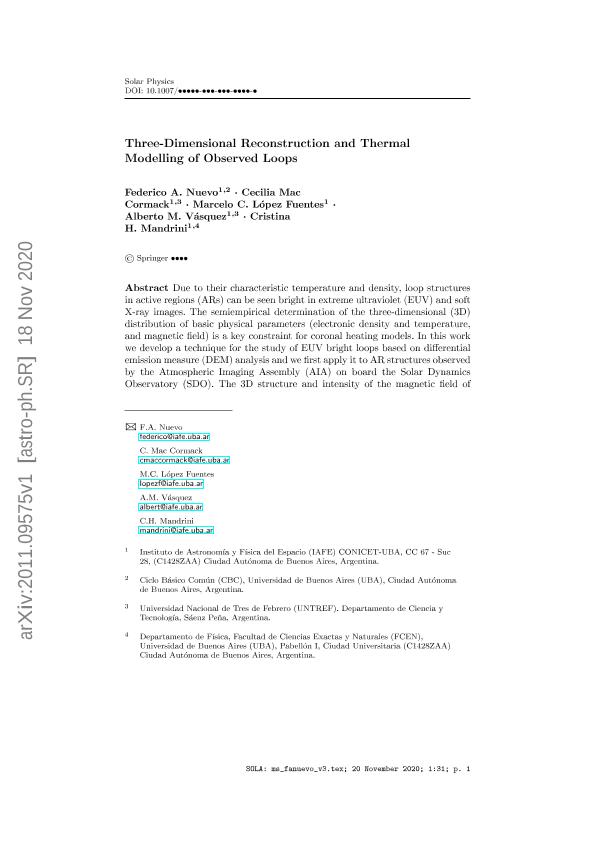Artículo
Three-Dimensional Reconstruction and Thermal Modeling of Observed Loops
Nuevo, Federico Alberto ; Mac Cormack, Cecilia
; Mac Cormack, Cecilia ; Lopez Fuentes, Marcelo Claudio
; Lopez Fuentes, Marcelo Claudio ; Vasquez, Alberto Marcos
; Vasquez, Alberto Marcos ; Mandrini, Cristina Hemilse
; Mandrini, Cristina Hemilse
 ; Mac Cormack, Cecilia
; Mac Cormack, Cecilia ; Lopez Fuentes, Marcelo Claudio
; Lopez Fuentes, Marcelo Claudio ; Vasquez, Alberto Marcos
; Vasquez, Alberto Marcos ; Mandrini, Cristina Hemilse
; Mandrini, Cristina Hemilse
Fecha de publicación:
03/12/2020
Editorial:
Springer
Revista:
Solar Physics
ISSN:
0038-0938
e-ISSN:
1573-093X
Idioma:
Inglés
Tipo de recurso:
Artículo publicado
Clasificación temática:
Resumen
Due to their characteristic temperature and density, loop structures in active regions (ARs) can be seen bright in extreme ultraviolet (EUV) and soft X-ray images. The semiempirical determination of the three-dimensional (3D) distribution of basic physical parameters (electronic density and temperature, and magnetic field) is a key constraint for coronal heating models. In this work we develop a technique for the study of EUV bright loops based on differential emission measure (DEM) analysis and we first apply it to AR structures observed by the Atmospheric Imaging Assembly (AIA) on board the Solar Dynamics Observatory (SDO). The 3D structure and intensity of the magnetic field of the observed EUV loops are modeled using force-free field extrapolations based on magnetograms taken by the Helioseismic and Magnetic Imager (HMI) on board SDO. In this work we report the results obtained for several bright loops identified in different ARs. Our analysis indicates that the mean and width of the temperature distributions are nearly invariant along the loop lengths. For a particular loop we study its temporal evolution and find that these characteristics remain approximately constant for most of its life time. The appearance and disappearance of this loop occurs at time-scales much shorter than its life time of ≈ 2.5 hours. The results of this analysis are compared with numerical simulations using the zero-dimensional (0D) hydrodynamic model, Enthalpy-Based Thermal Evolution of Loops (EBTEL). We study two alternative heating scenarios: first, we apply a constant heating rate assuming loops in quasi-static equilibrium, and second, we heat the loops using impulsive events or nanoflares. We find that all the observed loops are overdense with respect to a quasi-static equilibrium solution and that the nanoflare heating better reproduces the observed densities and temperatures.
Archivos asociados
Licencia
Identificadores
Colecciones
Articulos(IAFE)
Articulos de INST.DE ASTRONOMIA Y FISICA DEL ESPACIO(I)
Articulos de INST.DE ASTRONOMIA Y FISICA DEL ESPACIO(I)
Citación
Nuevo, Federico Alberto; Mac Cormack, Cecilia; Lopez Fuentes, Marcelo Claudio; Vasquez, Alberto Marcos; Mandrini, Cristina Hemilse; Three-Dimensional Reconstruction and Thermal Modeling of Observed Loops; Springer; Solar Physics; 295; 12; 3-12-2020; 1-25
Compartir
Altmétricas



